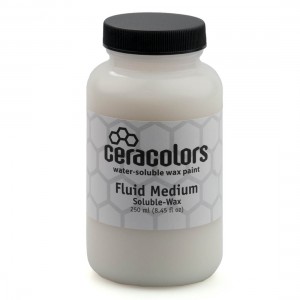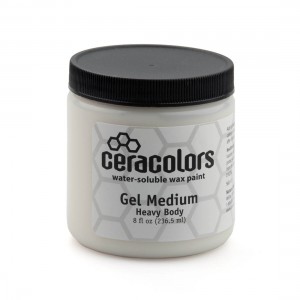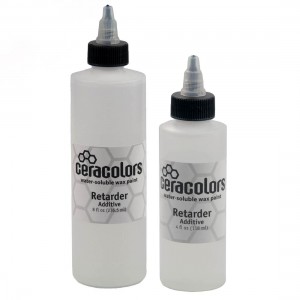
Ceracolors Mediums, Gels and Pastes offer artists unlimited control of Ceracolors water-soluble wax colors. Use mediums to control transparency, viscosity and consistency. Ceracolors Mediums can be thought of as colorless wax paints, as they are composed of the same or similar waxes as are Ceracolors paints. They are the “glue” or binder that dry to form continuous, durable films.
Fluid Medium

A general purpose liquid medium useful for creating glazes, extending colors, and increasing translucency. Has a unique property that promotes flow and leveling.
This section lists some typical uses of Fluid Medium, but it is not intended to be exhaustive. New and different ways to successfully use these products are always being discovered.
Extend Paint: Adding Fluid Medium to Ceracolors can increase transparency, as well as extend paint. Extending Ceracolors with Fluid Medium allows the paint to go further, while maintaining a much higher quality than “student grade” paints. Fluid Medium can be added to Ceracolors in any amount desired.
Increase Transparency: Adding Fluid Medium to paint can increase the transparency of Ceracolors.
Alter Consistency: Mixing Fluid Medium into thicker mediums, like Ceracolors Paste, will thin the paint and increase its flow. For additional body, paints can be mixed with Gel Medium. All Ceracolors mediums are compatible with the entire family of Ceracolors products.
Glue or Adhere: Fluid Medium can be used as an adhesive in collage when using materials that are porous and not water-sensitive. Other materials, such as glass, metals and plastics, should be avoided.
Make Paint: Fluid Medium can be used as a binder when creating paints from dry pigments.
Directions
Add Ceracolors Fluid Medium directly to paint on the palette or in a container. Fluid Medium can be added in any amount desired.
Composition
Ceracolors Fluid Medium is composed of beeswax and other waxes from natural sources, polyterpene resin (also derived from a natural source) and emulsifiers.
Heath and Safety
There are no acute or known chronic health hazards associated with the anticipated use of this product (most chemicals are not fully tested for chronic toxicity). Always protect yourself against potentially unknown chronic hazards of this and other chemical products by keeping them out of your body. Do this by avoiding ingestion, excessive skin contact, and inhalation of spraying mists, sanding dusts and vapors from heating. Conforms to ASTM D-4236.
Gel (Heavy Body)

Add Ceracolors Gel to Ceracolors paint for thick, impasto-like applications of paint.
Pastes differ from gels in that they are opaque and may contain calcite (chalk), bentonite (diatomaceous earth), fibers, clay or other fillers resulting in a white finish with a variety of textures and properties. Pastes can also be used to create textured foundations for painting.
This section lists some typical uses of Gel Medium, but it is not intended to be exhaustive. New and different ways to successfully use these products are always being discovered.
Extend Paint: Adding Gel to Ceracolors can increase transparency, as well as extend paint. Extending Ceracolors with Gel allows the paint to go further, while maintaining a much higher quality than “student grade” paints. Gel can be added to Ceracolors in any amount desired.
Increase Transparency: Adding Gel to paint can increase the transparency of Ceracolors.
Alter Consistency: Mixing Gel into Ceracolors, will thicken the paint, and provide additional body. All Ceracolors mediums are compatible with the entire family of Ceracolors products.
Glue or Adhere: Gel can be used as an adhesive in collage when using materials that are porous and not water-sensitive. Other materials, such as glass, metals and plastics, should be avoided.
Make Paint: Gel can be used as a binder when creating paints from dry pigments.
Directions
Add to Ceracolors Gel directly to paint on the palette or in a container. Gel can be added in any amount desired.
Composition
Ceracolors Fluid Medium is composed of beeswax and other waxes from natural sources, polyterpene resin (also derived from a natural source) and emulsifiers.
Heath and Safety
There are no acute or known chronic health hazards associated with the anticipated use of this product (most chemicals are not fully tested for chronic toxicity). Always protect yourself against potentially unknown chronic hazards of this and other chemical products by keeping them out of your body. Do this by avoiding ingestion, excessive skin contact, and inhalation of spraying mists, sanding dusts and vapors from heating. Conforms to ASTM D-4236.
Retarder Additive

Add Retarder to Ceracolors to increase the open time, for “wet-in-wet” techniques and to reduce skinning on the palette. Do not add excess Retarder or paint will not dry.
This section lists some typical uses of Retarder Additive, but it is not intended to be exhaustive. New and different ways to successfully use these products are always being discovered.
Extend Open Time: Adding Retarder to Ceracolors can increase the open time of the paint for “wet-in-wet” techniques and reduce skinning on the palette.
Make Paint: Add Retarder to Fluid Medium to increase the open time of the paint you can make from dry pigments.
Directions
Add Retarder dropwise to Ceracolors to increase the open time and to reduce skinning on the palette. Do not add excess Retarder or paint will not dry.
Composition
Ceracolors Retarder is composed of propylene glycol and other wetting agents.
Heath and Safety
There are no acute or known chronic health hazards associated with the anticipated use of this product (most chemicals are not fully tested for chronic toxicity). Always protect yourself against potentially unknown chronic hazards of this and other chemical products by keeping them out of your body. Do this by avoiding ingestion, excessive skin contact, and inhalation of spraying mists, sanding dusts and vapors from heating. Conforms to ASTM D-4236.